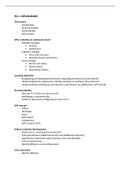HC 5 – Self and Identity
This lecture
- Introduction
- Personal identity
- Social identity
- Self-concept
Why is identity an adolescent issue?
- Biological changes
Puberty
Appearance
- Cognitive changes
More self-conscious
Develop a future orientation
- Social changes
Norms and values
Social choices
Educational choices
Learning objectives
- Recognizing and distinguishing theories regarding personal and social identity
- Understanding how adolescents’ identity develops according to these theories
- Understanding contemporary perspectives and research on adolescents’ self-concept
Personal identity
- Who am I? in terms of a sense of self
- Identifying as someone who…
- Central is the process of figuring out who one is
Self concept
- Values
- Attributes
- Goals
- Self-esteem
- Competence
- Self-concept clarity
Erikson’s Identity Development
- Adolescence = psychosocial moratorium
Time gap between childhood security and adulthood autonomy
- Adolescents experiment with numerous roles and identities
- Crisis in adolescence:
Identity diffusion versus achievement
Crisis outcomes
- Identity diffusion
, Failure to form a stable and secure identity
- Identity achievement
Establishing a clear and definite sense of who you are and how you fit into the
world around you
Marcia’s 4 stages model
- Identity achievement generally not established before age 18
- College years prolong psychosocial moratorium
- Over time, diffusion and moratorium decrease and achievement increases
Dual cycle models
- Adolescents do not begin with a blank slate
- Identity is not a static status process but a cyclic process
- Identity formation is a process of continuous interplay between commitment,
reconsideration, and in-depth exploration
- Identity formation occurs in several domains (e.g., educational and interpersonal)
and becomes increasingly complex over time
,Crocetti et al. model
Personal identity: summary
- Refers to identity search and commitment
- Goal is a coherent sense of self
- Continuous (across time and place)
- Develops through exploration and commitment on various domains
Identity & gender
- Gender identity
One’s sense of oneself as a male, female, or transgender
- Sexual orientation
Whether one is sexually attracted to individuals of the same sex, other sex, or
both
- Gender-role behavior
The extent to which an individual behaves in traditionally ‘masculine’ or
‘feminine’ ways
These concept are not related
What do we see in development?
- Childhood
Labelling around 2, preference for gender-congruent toys, play mates, future
profession, accomplishments
Compared to girls, boys have stronger gender-identity, are more content with
their gender, place more pressure on themselves to conform to the expected
gender roles
- Adolescence
Sexual orientation develops
Beliefs about gender roles become more flexible; more and more
androgynous
, Societal pressure for gender-stereotypic behavior increases (gender
intensification hypothesis)
Benefits of peer identity (Sameroff, 2010)
- Secure environment for exploration
- More diverse peer groups = more
exploration and smoother transition in
adulthood
- Pathway from external regulation by
others to self-determination
Gender and peer identity in adolescence
- Three adolescent groups: early (12-13 years), mid (15-16 years), late (18-20 years)
- Types of ingroups: gender and peer (i.e., populars, normal, and nerd)
- Outcome variables: self-typicality (how much self is perceived typical of ingroup) and
ingroup favoritism (allocating money to ingroup vs outgroup)
Self-typicality
Ingroup favoritism






